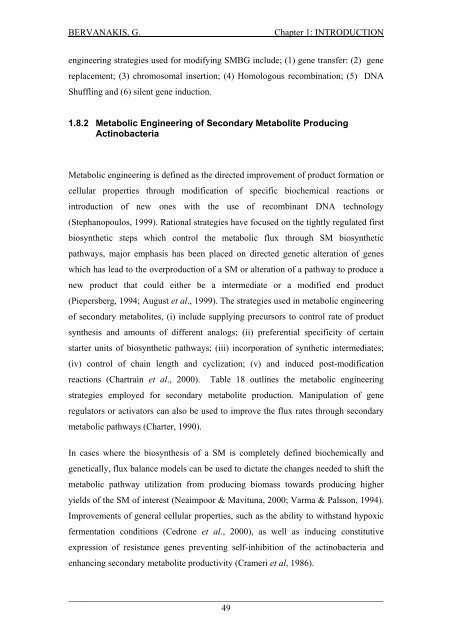Detection and Expression of Biosynthetic Genes in Actinobacteria ...
Detection and Expression of Biosynthetic Genes in Actinobacteria ...
Detection and Expression of Biosynthetic Genes in Actinobacteria ...
Create successful ePaper yourself
Turn your PDF publications into a flip-book with our unique Google optimized e-Paper software.
BERVANAKIS, G.Chapter 1: INTRODUCTIONeng<strong>in</strong>eer<strong>in</strong>g strategies used for modify<strong>in</strong>g SMBG <strong>in</strong>clude; (1) gene transfer: (2) genereplacement; (3) chromosomal <strong>in</strong>sertion; (4) Homologous recomb<strong>in</strong>ation; (5) DNAShuffl<strong>in</strong>g <strong>and</strong> (6) silent gene <strong>in</strong>duction.1.8.2 Metabolic Eng<strong>in</strong>eer<strong>in</strong>g <strong>of</strong> Secondary Metabolite Produc<strong>in</strong>gAct<strong>in</strong>obacteriaMetabolic eng<strong>in</strong>eer<strong>in</strong>g is def<strong>in</strong>ed as the directed improvement <strong>of</strong> product formation orcellular properties through modification <strong>of</strong> specific biochemical reactions or<strong>in</strong>troduction <strong>of</strong> new ones with the use <strong>of</strong> recomb<strong>in</strong>ant DNA technology(Stephanopoulos, 1999). Rational strategies have focused on the tightly regulated firstbiosynthetic steps which control the metabolic flux through SM biosyntheticpathways, major emphasis has been placed on directed genetic alteration <strong>of</strong> geneswhich has lead to the overproduction <strong>of</strong> a SM or alteration <strong>of</strong> a pathway to produce anew product that could either be a <strong>in</strong>termediate or a modified end product(Piepersberg, 1994; August et al., 1999). The strategies used <strong>in</strong> metabolic eng<strong>in</strong>eer<strong>in</strong>g<strong>of</strong> secondary metabolites, (i) <strong>in</strong>clude supply<strong>in</strong>g precursors to control rate <strong>of</strong> productsynthesis <strong>and</strong> amounts <strong>of</strong> different analogs; (ii) preferential specificity <strong>of</strong> certa<strong>in</strong>starter units <strong>of</strong> biosynthetic pathways; (iii) <strong>in</strong>corporation <strong>of</strong> synthetic <strong>in</strong>termediates;(iv) control <strong>of</strong> cha<strong>in</strong> length <strong>and</strong> cyclization; (v) <strong>and</strong> <strong>in</strong>duced post-modificationreactions (Chartra<strong>in</strong> et al., 2000). Table 18 outl<strong>in</strong>es the metabolic eng<strong>in</strong>eer<strong>in</strong>gstrategies employed for secondary metabolite production. Manipulation <strong>of</strong> generegulators or activators can also be used to improve the flux rates through secondarymetabolic pathways (Charter, 1990).In cases where the biosynthesis <strong>of</strong> a SM is completely def<strong>in</strong>ed biochemically <strong>and</strong>genetically, flux balance models can be used to dictate the changes needed to shift themetabolic pathway utilization from produc<strong>in</strong>g biomass towards produc<strong>in</strong>g higheryields <strong>of</strong> the SM <strong>of</strong> <strong>in</strong>terest (Neaimpoor & Mavituna, 2000; Varma & Palsson, 1994).Improvements <strong>of</strong> general cellular properties, such as the ability to withst<strong>and</strong> hypoxicfermentation conditions (Cedrone et al., 2000), as well as <strong>in</strong>duc<strong>in</strong>g constitutiveexpression <strong>of</strong> resistance genes prevent<strong>in</strong>g self-<strong>in</strong>hibition <strong>of</strong> the act<strong>in</strong>obacteria <strong>and</strong>enhanc<strong>in</strong>g secondary metabolite productivity (Crameri et al, 1986)._____________________________________________________________________49















